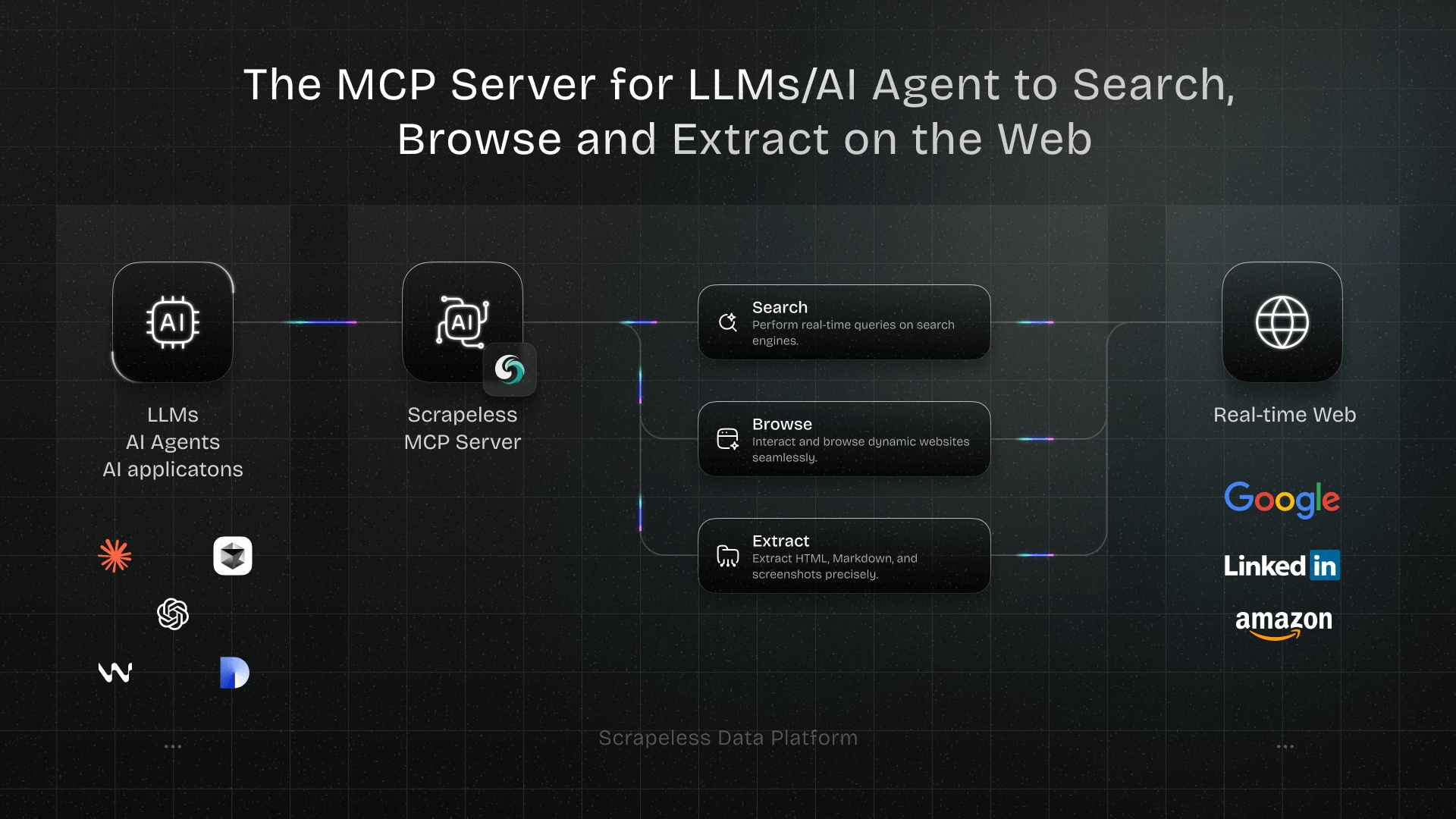How To Make API Calls With Python in 2025
Expert Network Defense Engineer
Key Takeaways
- Making API calls with Python is fundamental for data exchange, web scraping, and integrating various services.
- The
requestslibrary is the de facto standard for synchronous HTTP requests in Python, offering a human-friendly API. - Effective API interaction in 2025 requires understanding various request types (GET, POST, PUT, DELETE), authentication methods, and robust error handling.
- This guide provides 10 detailed solutions for making API calls with Python, including code examples and best practices.
- For complex web data extraction, especially from challenging APIs or websites, specialized tools like Scrapeless can significantly simplify the process.
Introduction
In the rapidly evolving digital landscape of 2025, the ability to programmatically interact with web services through Application Programming Interfaces (APIs) is an indispensable skill for developers, data scientists, and automation engineers. APIs serve as the backbone of modern applications, enabling seamless data exchange, service integration, and the creation of powerful, interconnected systems. Python, with its simplicity, extensive libraries, and vibrant community, has emerged as the language of choice for making API calls, facilitating everything from fetching real-time data to automating complex workflows. This comprehensive guide, "How To Make API Calls With Python in 2025," will delve into the essential techniques and best practices for interacting with APIs using Python. We will explore 10 detailed solutions, complete with practical code examples, covering various aspects from basic requests to advanced authentication, error handling, and performance optimization. For those grappling with the complexities of web data extraction, particularly from challenging sources, Scrapeless offers a robust and efficient alternative to traditional API interactions.
Understanding APIs and HTTP Methods
Before diving into Python code, it's crucial to grasp the fundamental concepts of APIs and the HTTP protocol. An API defines a set of rules that dictate how software components should interact. Most web APIs today are RESTful, meaning they adhere to the principles of Representational State Transfer, using standard HTTP methods to perform actions on resources [1].
HTTP Methods for API Interaction:
- GET: Used to retrieve data from a server. It should not have any side effects on the server (i.e., it's idempotent and safe). Example: fetching a list of products.
- POST: Used to send data to the server to create a new resource. It is not idempotent, meaning multiple identical requests may create multiple resources. Example: submitting a new user registration.
- PUT: Used to send data to the server to update an existing resource, or create it if it doesn't exist. It is idempotent. Example: updating a user's profile.
- DELETE: Used to remove a resource from the server. It is idempotent. Example: deleting a specific item from a database.
Understanding these methods is key to effectively communicating with any API.
10 Essential Solutions for Making API Calls with Python
1. Making Basic GET Requests with requests
The requests library is the most popular and recommended library for making HTTP requests in Python. It simplifies complex HTTP requests, making them human-friendly and intuitive. A basic GET request is often the starting point for interacting with most APIs [2].
Code Operation Steps:
- Install the
requestslibrary: If you haven't already, install it using pip:bashpip install requests - Import
requestsand make a GET request:This code snippet demonstrates how to fetch a single post from a public API. Thepythonimport requests # Define the API endpoint URL api_url = "https://jsonplaceholder.typicode.com/posts/1" # Make a GET request to the API response = requests.get(api_url) # Check if the request was successful (status code 200) if response.status_code == 200: # Parse the JSON response data = response.json() print("Successfully fetched data:") print(data) else: print(f"Error fetching data: {response.status_code}") print(response.text)response.json()method automatically parses the JSON content into a Python dictionary, making it easy to work with the data.
2. Sending Data with POST Requests
When you need to create new resources or submit data to an API, you'll use a POST request. This involves sending a payload (usually JSON or form data) in the request body [3].
Code Operation Steps:
- Define the API endpoint and the data payload:
Thepython
import requests import json api_url = "https://jsonplaceholder.typicode.com/posts" new_post_data = { "title": "My New API Post", "body": "This is the content of my new post.", "userId": 1 } # Make a POST request with JSON data response = requests.post(api_url, json=new_post_data) # Check if the request was successful (status code 201 for creation) if response.status_code == 201: created_data = response.json() print("Successfully created new post:") print(created_data) else: print(f"Error creating post: {response.status_code}") print(response.text)jsonparameter inrequests.post()automatically serializes the Python dictionary to JSON and sets theContent-Typeheader toapplication/json.
3. Handling Query Parameters
Many GET requests require query parameters to filter, sort, or paginate results. The requests library makes it easy to add these parameters to your URL [4].
Code Operation Steps:
- Define parameters as a dictionary:
Thepython
import requests api_url = "https://jsonplaceholder.typicode.com/comments" params = { "postId": 1, "_limit": 5 } # Make a GET request with query parameters response = requests.get(api_url, params=params) if response.status_code == 200: comments = response.json() print(f"Fetched {len(comments)} comments for postId 1:") for comment in comments: print(f"- {comment['name']}: {comment['body'][:50]}...") else: print(f"Error fetching comments: {response.status_code}") print(response.text)paramsargument automatically encodes the dictionary into URL query strings (e.g.,?postId=1&_limit=5).
4. Customizing Request Headers
HTTP headers provide metadata about the request or response. Customizing headers is crucial for authentication, specifying content types, or mimicking browser behavior (e.g., User-Agent) [5].
Code Operation Steps:
- Define headers as a dictionary:
This example sends a request topython
import requests api_url = "https://httpbin.org/headers" custom_headers = { "User-Agent": "MyPythonAPIClient/1.0", "Accept": "application/json", "X-Custom-Header": "MyValue" } # Make a GET request with custom headers response = requests.get(api_url, headers=custom_headers) if response.status_code == 200: print("Response headers:") print(response.json()['headers']) else: print(f"Error: {response.status_code}") print(response.text)httpbin.org(a service for testing HTTP requests) and prints the headers it received, demonstrating how custom headers are passed.
5. Implementing Basic Authentication
Many APIs require authentication to access protected resources. Basic authentication involves sending a username and password with each request, typically encoded in the Authorization header [6].
Code Operation Steps:
- Use the
authparameter with a tuple of (username, password):Thepythonimport requests # Replace with your actual API endpoint and credentials api_url = "https://api.example.com/protected_resource" username = "your_username" password = "your_password" # Make a GET request with basic authentication response = requests.get(api_url, auth=(username, password)) if response.status_code == 200: print("Authentication successful! Data:") print(response.json()) elif response.status_code == 401: print("Authentication failed: Invalid credentials.") else: print(f"Error: {response.status_code}") print(response.text)requestslibrary handles the Base64 encoding of the credentials for you.
6. Handling API Keys and Token-Based Authentication
API keys and tokens (like OAuth tokens or JWTs) are common authentication methods. API keys are often sent as query parameters or custom headers, while tokens are typically sent in the Authorization header with a Bearer prefix [7].
Code Operation Steps:
-
API Key as Query Parameter:
pythonimport requests api_url = "https://api.example.com/data" api_key = "YOUR_API_KEY" params = {"api_key": api_key} response = requests.get(api_url, params=params) # ... handle response ... -
Token-Based Authentication (Bearer Token):
pythonimport requests api_url = "https://api.example.com/protected_data" access_token = "YOUR_ACCESS_TOKEN" headers = { "Authorization": f"Bearer {access_token}" } response = requests.get(api_url, headers=headers) # ... handle response ...Token-based authentication is more secure than basic authentication as tokens can be revoked and often have limited lifespans.
7. Managing Sessions for Persistent Connections and Cookies
For multiple requests to the same host, especially when dealing with authentication or cookies, using a requests.Session object is highly efficient. It persists certain parameters across requests, such as cookies, headers, and authentication credentials [8].
Code Operation Steps:
- Create a
Sessionobject:Using sessions improves performance by reusing the underlying TCP connection and simplifies cookie management, which is vital for maintaining stateful interactions with APIs.pythonimport requests # Create a session object session = requests.Session() # Example: Log in to an API (this would typically involve a POST request) login_url = "https://api.example.com/login" login_payload = {"username": "testuser", "password": "testpass"} session.post(login_url, json=login_payload) # Now, any subsequent requests made with this session object will automatically include cookies protected_data_url = "https://api.example.com/dashboard" response = session.get(protected_data_url) if response.status_code == 200: print("Accessed protected data successfully with session:") print(response.json()) else: print(f"Error accessing protected data: {response.status_code}") print(response.text)
8. Implementing Robust Error Handling and Retries
API calls can fail due to network issues, server errors, or rate limiting. Implementing proper error handling and retry mechanisms is crucial for building resilient applications [9].
Code Operation Steps:
- Use
try-exceptblocks and checkresponse.raise_for_status():This example demonstrates catching variouspythonimport requests from requests.exceptions import HTTPError, ConnectionError, Timeout, RequestException import time api_url = "https://api.example.com/sometimes_fails" max_retries = 3 retry_delay = 5 # seconds for attempt in range(max_retries): try: response = requests.get(api_url, timeout=10) # Set a timeout response.raise_for_status() # Raise an HTTPError for bad responses (4xx or 5xx) print(f"Attempt {attempt + 1}: Success!") print(response.json()) break # Exit loop on success except HTTPError as http_err: print(f"Attempt {attempt + 1}: HTTP error occurred: {http_err}") except ConnectionError as conn_err: print(f"Attempt {attempt + 1}: Connection error occurred: {conn_err}") except Timeout as timeout_err: print(f"Attempt {attempt + 1}: Timeout error occurred: {timeout_err}") except RequestException as req_err: print(f"Attempt {attempt + 1}: An unexpected error occurred: {req_err}") if attempt < max_retries - 1: print(f"Retrying in {retry_delay} seconds...") time.sleep(retry_delay) else: print("Max retries reached. Giving up.")requestsexceptions and implementing a simple retry logic with a delay. For more advanced retry strategies (e.g., exponential backoff), consider libraries likeurllib3.util.retryorrequests-toolbelt.
9. Handling Timeouts
API calls can hang indefinitely if the server doesn't respond. Setting timeouts is essential to prevent your application from freezing and to ensure responsiveness [10].
Code Operation Steps:
- Use the
timeoutparameter inrequestsmethods:Thepythonimport requests from requests.exceptions import Timeout api_url = "https://api.example.com/slow_endpoint" try: # Set a timeout of 5 seconds for the entire request (connection + read) response = requests.get(api_url, timeout=5) response.raise_for_status() print("Request successful within timeout.") print(response.json()) except Timeout: print("The request timed out after 5 seconds.") except requests.exceptions.RequestException as e: print(f"An error occurred: {e}")timeoutparameter can be a single value (for both connection and read timeouts) or a tuple(connect_timeout, read_timeout)for more granular control.
10. Making Asynchronous API Calls
For applications that need to make many API calls concurrently without blocking the main thread, asynchronous programming is highly beneficial. Python's asyncio library, combined with an async HTTP client like httpx or aiohttp, enables efficient parallel API interactions.
Code Operation Steps (using httpx):
- Install
httpx:bashpip install httpx - Implement asynchronous requests:
Asynchronous API calls are ideal for scenarios like fetching data from multiple endpoints simultaneously, significantly reducing the total execution time compared to sequential requests.python
import asyncio import httpx async def fetch_url(client, url): try: response = await client.get(url, timeout=10) response.raise_for_status() return response.json() except httpx.RequestError as exc: print(f"An error occurred while requesting {exc.request.url!r}: {exc}") return None async def main(): urls = [ "https://jsonplaceholder.typicode.com/posts/1", "https://jsonplaceholder.typicode.com/posts/2", "https://jsonplaceholder.typicode.com/posts/3", ] async with httpx.AsyncClient() as client: tasks = [fetch_url(client, url) for url in urls] results = await asyncio.gather(*tasks) for i, result in enumerate(results): if result: print(f"Result for {urls[i]}: {result['title']}") if __name__ == "__main__": asyncio.run(main())
Comparison Summary: Python HTTP Libraries
Choosing the right library depends on your project's needs. Here's a comparison of popular Python HTTP clients:
| Feature / Library | requests (Synchronous) |
httpx (Synchronous & Asynchronous) |
aiohttp (Asynchronous) |
|---|---|---|---|
| Primary Use | General HTTP requests | General HTTP requests, async | Async HTTP requests |
| Sync Support | Yes | Yes | No (async only) |
| Async Support | No | Yes | Yes |
| API Style | Simple, human-friendly | requests-like, modern |
asyncio-native |
| HTTP/2 Support | No (requires requests-http2) |
Yes | Yes |
| Proxy Support | Yes | Yes | Yes |
| Session Mgmt. | requests.Session |
httpx.Client, httpx.AsyncClient |
aiohttp.ClientSession |
| Learning Curve | Low | Low to Moderate | Moderate |
For most everyday synchronous API calls, requests remains the go-to choice due to its simplicity and widespread adoption. However, for modern applications requiring asynchronous operations or HTTP/2 support, httpx offers a compelling and flexible alternative, while aiohttp is a powerful, low-level option for purely async projects.
Why Scrapeless is Your Ally for Complex API Interactions
While Python's requests and other HTTP libraries provide excellent tools for making API calls, certain scenarios, especially those involving web scraping or interacting with highly protected APIs, can introduce significant complexities. Websites often employ advanced anti-bot measures, CAPTCHAs, and dynamic content that can make direct API calls challenging or even impossible without extensive custom development.
This is where Scrapeless shines as a powerful ally. Scrapeless is a fully managed web scraping API that abstracts away these complexities. Instead of spending valuable time implementing proxy rotation, User-Agent management, CAPTCHA solving, or JavaScript rendering, you can simply send your requests to the Scrapeless API. It handles all the underlying challenges, ensuring that you receive clean, structured data reliably. For developers who need to integrate data from websites that don't offer a public API, or whose APIs are heavily protected, Scrapeless acts as a robust intermediary, simplifying the data acquisition process and allowing you to focus on leveraging the data rather than fighting technical hurdles.
Conclusion and Call to Action
Mastering API calls with Python is a cornerstone skill in today's interconnected world. From basic GET and POST requests to advanced authentication, robust error handling, and asynchronous operations, Python's rich ecosystem, particularly the requests library, provides powerful and flexible tools for interacting with virtually any web service. By understanding the 10 solutions detailed in this guide, you are well-equipped to build resilient and efficient applications that seamlessly integrate with various APIs.
However, the journey of data acquisition, especially from the open web, often presents unique challenges that go beyond standard API interactions. When faced with complex web scraping scenarios, anti-bot systems, or dynamic content, traditional methods can become cumbersome. Scrapeless offers an elegant solution, providing a managed API that simplifies these intricate tasks, ensuring reliable and efficient data delivery.
Ready to streamline your API integrations and conquer complex web data challenges?
Explore Scrapeless and enhance your data acquisition capabilities today!
FAQ (Frequently Asked Questions)
Q1: What is the requests library in Python?
A1: The requests library is a popular, non-standard Python library for making HTTP requests. It's known for its user-friendly API, which simplifies sending various types of HTTP requests (GET, POST, PUT, DELETE) and handling responses, making it the de facto standard for synchronous web interactions in Python.
Q2: What is the difference between synchronous and asynchronous API calls?
A2: Synchronous API calls execute one after another; the program waits for each call to complete before moving to the next. Asynchronous API calls, on the other hand, allow multiple requests to be initiated concurrently without waiting for each to finish, enabling more efficient use of resources and faster execution for I/O-bound tasks, especially when making many independent calls.
Q3: How do I handle authentication for API calls in Python?
A3: Authentication for API calls in Python can be handled in several ways: basic authentication (username/password), API keys (sent as headers or query parameters), or token-based authentication (e.g., OAuth, JWT, sent as a Bearer token in the Authorization header). The requests library provides built-in support for basic auth and allows easy customization of headers for API keys and tokens.
Q4: Why is error handling important when making API calls?
A4: Error handling is crucial because API calls can fail for various reasons, such as network issues, server errors (e.g., 404 Not Found, 500 Internal Server Error), or timeouts. Robust error handling (using try-except blocks and checking response.raise_for_status()) prevents application crashes, provides informative feedback, and allows for retry mechanisms, making your application more resilient.
Q5: Can I use Python to interact with APIs that require JavaScript rendering?
A5: Yes, but the standard requests library alone cannot execute JavaScript. For APIs or websites that heavily rely on JavaScript rendering to display content, you would typically need to integrate with a headless browser automation library like Selenium or Playwright. Alternatively, specialized web scraping APIs like Scrapeless can handle JavaScript rendering automatically, simplifying the process for you.
References
[1] Integrate.io: An Introduction to REST API with Python: Integrate.io REST API
[2] Real Python: Python's Requests Library (Guide): Real Python Requests
[3] DataCamp: Getting Started with Python HTTP Requests for REST APIs: DataCamp HTTP Requests
[4] Nylas: How to Use the Python Requests Module With REST APIs: Nylas Python Requests
At Scrapeless, we only access publicly available data while strictly complying with applicable laws, regulations, and website privacy policies. The content in this blog is for demonstration purposes only and does not involve any illegal or infringing activities. We make no guarantees and disclaim all liability for the use of information from this blog or third-party links. Before engaging in any scraping activities, consult your legal advisor and review the target website's terms of service or obtain the necessary permissions.



